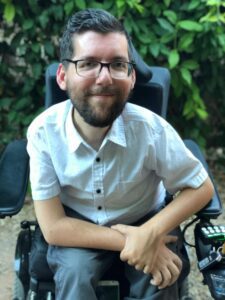October is National Disability Employment Awareness Month, with an official theme of Increasing Access and Opportunity. Throughout the month, we have been posting stories about adults with SMA in the workforce and are pleased to share this perspective column from Spencer Cook, as seen in the latest Fall issue of Directions.
Living with a disability in the United States has never been easier. Through the ADA and the Architectural Barriers Act, many of the obstacles that made working and participating in society impossible for disabled people have been removed. Medicaid waiver programs provide many with self-directed attendant care, enabling people with all kinds of disabilities to live independently rather than in institutions. I am a grateful beneficiary of these policies and programs. Nowhere in history have people with disabilities been afforded so much freedom and support.
 However, as a working person with SMA, I must admit that National Disability Employment Awareness Month inspires a deep ambivalence in me. While I applaud the intention behind the campaign, it fails to address the primary obstacle facing many disabled people who attempt to earn a living: the fact that eligibility for essential services is determined by not only the individual’s physical capability but also by their financial need.
However, as a working person with SMA, I must admit that National Disability Employment Awareness Month inspires a deep ambivalence in me. While I applaud the intention behind the campaign, it fails to address the primary obstacle facing many disabled people who attempt to earn a living: the fact that eligibility for essential services is determined by not only the individual’s physical capability but also by their financial need.
Though I expect most people reading this will be familiar with the issue, I’ll summarize it here. Unless they can pay for it themselves, many people with SMA or another physical disability will at some point rely on state-funded attendant care. Because attendant care is provided through Medicaid waiver programs, eligibility is based in part on financial need. Once part of a program, they are subject to income limits and liquid asset caps. In Texas, I can make $2,349 per month. The asset cap, established in 1989 and unchanged since, is $2,000. But here’s the real sticking point: the care I receive by artificially restricting my savings and earnings costs about $90,000 per year.
As you can see, this puts people who rely on attendant care into an impossible situation. To maintain the benefits that are absolutely essential for our survival, we are forced to accept indefinite poverty. If I were to pay for my own care and maintain my modest standard of living, my income would need to jump from the allowed maximum of $28,881 to about $120,000 in a single year; quite a feat for anyone. This gap between what you can make while receiving essential services and what you would need to earn to pay for those services yourself sends a very clear message: do not risk trying.
Quite simply, the eligibility requirements work in direct opposition to the goals of the ADA. Instead of promoting independence and inclusion, they force dependence. Instead of helping disabled people pursue meaningful, sustaining careers, we are incentivized to remain in positions we have outgrown, if we work at all. Without exaggeration, the struggle and uncertainty around maintaining my eligibility while working has been the single most difficult aspect of my disability I have dealt with as an adult. I have been averse to risks that I probably should have taken. I have succumbed to a lack of motivation, feeling trapped in a hopeless situation. This is a clear instance of policy actually amplifying the effects of disability rather than mitigating them. To live in fear of losing your means of survival is much more difficult to bear than simply being unable to walk.
I am sure someone reading this will suggest that Medicaid Buy-In or ABLE accounts might help. For some people, these are workable solutions and that is wonderful. For many others, however, these options offer only marginal improvements to an unjust situation. Though they do slightly raise the income limits and asset caps, the results are much the same. Quite frankly, you will still always be poor. Saving enough money for a significant emergency will still be impossible.
Though I do work and earn money, I have not even come close to solving this problem for myself. The solutions I have found are precarious at best; I have no guarantee that some administrators won’t find an error while reviewing my case and revoke the services on which my independence is based with the stroke of a pen. For now, the best I can do is to work and plan a future within the limitations of the current system. Though I am working towards someday paying for my own care, it is still a way off.
True accessibility entails more than physical access and a lack of discrimination; it is about self-determination. An accessible society is one where people can pursue their lives and careers fully and freely without fear of losing the services on which their lives depend. Until essential services are guaranteed to all regardless of their financial situation, the potential of people with disabilities will always be stifled and work will never be truly accessible.



